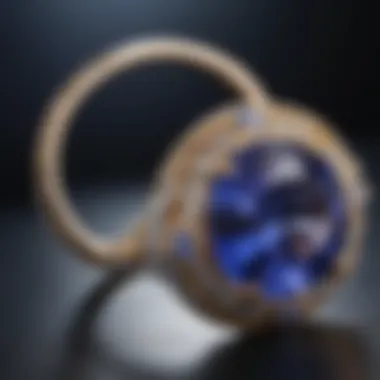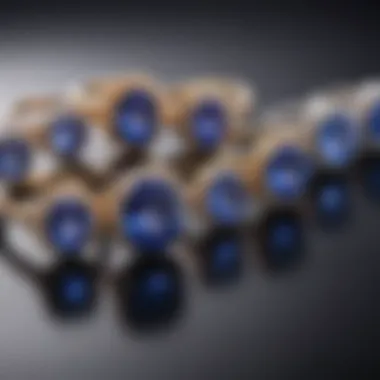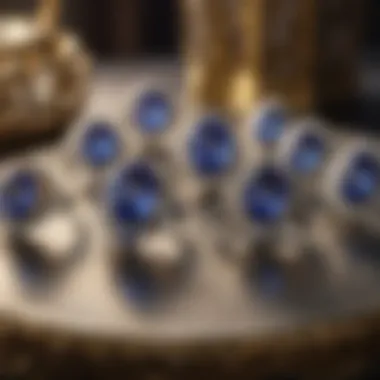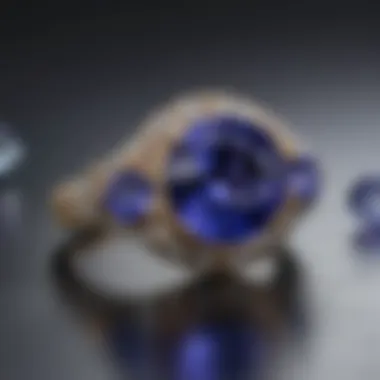Understanding Tanzanite Ring Costs: An In-Depth Guide


Intro
Tanzanite, a captivating blue-violet gemstone, has gained attention for its unique color and allure. Understanding the costs associated with tanzanite rings requires a closer look at the factors that influence their pricing. In this guide, we will explore these elements, from the gemstone's rarity and quality to emerging market trends.
Gemstone Overview
Definition of Gemstones
Gemstones are prized natural minerals or rocks that are cut and polished for use in jewelry. They are valued for their beauty, rarity, and durability. Tanzanite, specifically, is a variety of the mineral zoisite and is known for its striking hues and clarity.
Classification of Gemstones
Gemstones are typically classified into two main categories: precious and semi-precious. Precious gemstones include diamonds, rubies, emeralds, and sapphires. Tanzanite is categorized as semi-precious, yet it often rivals the beauty of its precious counterparts.
- Precious Gemstones
- Semi-Precious Gemstones
- Diamonds
- Rubies
- Sapphires
- Emeralds
- Amethyst
- Citrine
- Garnet
- Tanzanite
Historical Significance
Origins of Gemstone Use
The use of gemstones dates back thousands of years, with ancient civilizations employing them for various purposes, including adornment, trade, and even spiritual significance. Tanzanite was discovered only in 1967 in Tanzania, making it a newcomer compared to other gemstones. Its unique discovery contributed to its mystique and value.
Cultural Insights: Gemstones in Ancient Civilizations
Many cultures have associated gemstones with power and protection. For example, in ancient Egypt, gemstones were believed to hold protective qualities. Similarly, tanzanite's vibrant color and rarity have led to its position in modern jewelry as a symbol of luxury and sophistication.
"Tanzanite has quickly become one of the most sought-after gemstones in the market due to its unique characteristics and limited geographical availability."
Understanding these historical contexts enriches the appreciation of tanzanite rings. As you delve deeper into their costs, consider the cultural and historical significance of this remarkable gemstone.
Prologue to Tanzanite
Understanding the significance of tanzanite within the realm of gemstones sets a foundational tone for this article. Tanzanite is not merely a beautiful stone; it encompasses rarity, vibrancy, and a deep cultural narrative. As a relatively recent discovery in the gemstone world, its unique properties and rich hues make it both sought after by collectors and captivating for jewelry designers.
Exploring tanzanite provides insights into various aspects such as its origins and the characteristics that contribute to its value. This understanding helps consumers appreciate the nuances involved when searching for a tanzanite ring. Diving into this topic enables potential buyers to make informed decisions, ensuring they recognize what elements drive costs.
Moreover, learning about tanzanite's historical context enriches the overall perception of the gemstone. Its ascent from a rock formation to a precious jewel illustrates how market dynamics and consumer preferences shape its valuation.
Overview of Tanzanite
Tanzanite is a blue-violet variety of the mineral zoisite. Its visual appeal lies in its distinct coloration, which can shift shades depending on the angle of light. This phenomenon, known as pleochroism, means that a single piece of tanzanite can exhibit different colors when viewed from various perspectives. This characteristic elevates its desirability, particularly among those who appreciate unique gemstones.
Originating from a small region near Mount Kilimanjaro in Tanzania, tanzanite is one of the few gemstones that can only be found in one place on Earth. This limited availability further enhances its rarity and potential value. Buyers should consider this factor when evaluating ring options since the cost often reflects the gemstone's availability in the market.
Tanzanite is often compared to sapphire, yet it stands apart due to its softer hues and distinctive overall appearance. A deeper understanding of these attributes allows consumers to better assess quality and pricing during their purchases.


Historical Significance
The discovery of tanzanite dates back to 1967, when a Masai herdsman stumbled upon stunning blue crystals in Tanzania. This marked the beginning of a gemstone that would intrigue and captivate buyers, jewelers, and collectors globally. In a short period, tanzanite went from being a noveltie to an instant classic, achieving a prestigious place in the gemstone market.
Tanzanite was subsequently marketed by Tiffany & Co., which played a significant role in promoting its allure. With such a pivotal endorsement, consumers began to recognize tanzanite as not just another gemstone, but as a luxurious choice worthy of investment. The marketing campaigns led to a surge in demand, and prices began to rise as collectors sought after this limited supply gem.
The cultural implications of tanzanite are also notable. Within Tanzania, it is often regarded as a symbol of royalty and luxury. This cultural significance adds another layer to its value, as acquiring such a gemstone can feel akin to holding a piece of history and cultural heritage.
Factors Affecting Tanzanite Ring Costs
Understanding the factors that influence the cost of tanzanite rings is crucial for anyone considering purchasing this unique gemstone. The interplay of various elements such as rarity, quality grades, size, carat weight, and origin all contribute significantly to pricing. A comprehensive grasp of these factors enables buyers to make informed decisions and ensures they receive fair value for their investment.
Rarity and Availability
The rarity of tanzanite is a prominent factor affecting its cost. Discovered only in Tanzania, this gemstone is found in a single source, making it inherently limited. The limited availability amplifies its desirability among collectors and jewelry lovers alike. As the global interest in tanzanite increases, the supply constraint becomes ever more relevant. A tanzanite ring has a special appeal, not just because of its aesthetics, but also because of the rarity associated with its discovery. This exclusivity often leads to higher prices in the market, which can fluctuate based on demand.
Quality Grades
When it comes to tanzanite, quality grades play a critical role in determining costs. The quality of tanzanite is largely evaluated on three specific aspects: clarity, color, and cut. Each of these factors can dramatically affect the overall value of the ring.
Clarity
Clarity refers to the absence of inclusions and blemishes within the gemstone. A high clarity grade means the tanzanite has fewer visible flaws, making it more desirable. Buyers often seek clarity as it enhances the brilliance and overall aesthetic of the ring. However, achieving perfect clarity is highly challenging in natural stones, leading to reduced supply for higher-clarity gems. This quality aspect impacts pricing significantly, with clearer stones typically commanding higher prices.
Color
The color of tanzanite is another significant factor influencing its value. This gemstone can exhibit a range of hues, from vibrant blues to deep purples. The most sought-after color is a rich, deep blue, often with a hint of violet. Color saturation and tone substantially affect desirability; therefore, gemstones displaying intense, vivid colors typically have higher price points. Nevertheless, personal preference also plays a role, as some buyers may prefer lighter or more muted tones.
Cut
The cut of the tanzanite influences its sparkle and performance. A well-executed cut not only enhances visual appeal but also maximizes the stone's brilliance and fire. Different shapes, such as oval, round, or cushion cuts, can appeal to diverse tastes, affecting their market value. The skill of the cutter can impact the price, as better cuts require more craftsmanship and precision. A stone cleverly cut presents a more attractive option, often translating into higher prices in the market.
Size and Carat Weight
Size and carat weight are essential elements when considering the cost of tanzanite rings. As a general rule, larger stones are rarer, which leads to higher demands and pricing. It is notable that even minor differences in carat weight can result in significant value differences. Buyers must balance their desire for size with budget considerations, as larger stones, especially of good quality, can be quite expensive.
Origin of the Gemstone
The origin of the tanzanite gemstone can also affect its price. Gems originating from specific sources, particularly those known for higher quality stones, often fetch more on the market. Tanzania remains the exclusive mining location for tanzanite, and as mining yields change, market fluctuations may occur. Buyers should take note of the origin, as it may influence not just the aesthetic value but the investment potential as well.
Understanding these factors provides essential insight into why tanzanite rings are priced as they are. Each element contributes intricately to the total valuation, giving buyers a complete picture necessary for making wise purchasing choices.
Market Trends in Tanzanite Pricing
Understanding the market trends in tanzanite pricing is essential for anyone looking to invest in or purchase tanzanite rings. The gemstone's price is influenced by various dynamic factors, including rarity, consumer demand, and economic conditions. This knowledge helps buyers navigate the complexities of the market, ensuring they make informed choices. Recognizing these trends provides perspective on how such variables may shape the future value of their purchases.
Current Market Prices
Currently, tanzanite prices vary significantly depending on quality and origin. On average, tanzanite rings can range from a few hundred to several thousand dollars. For example, a simple tanzanite ring may start at around four hundred dollars, while high-quality stones set in gold can exceed five thousand dollars. The most sought-after stones, particularly those with deep blue color and excellent clarity, tend to command premium prices. Market data show that prices have been relatively stable, reflecting a balance between supply and demand. Buyers should check multiple sources for pricing to ensure they are getting fair market value.
Historical Price Changes


Examining the historical prices of tanzanite highlights its price volatility and trends over the past decades. Tanzanite was discovered in 1967, and its initial prices were lower due to its abundance. However, as extraction methods evolved and the gemstone became recognized for its beauty and rarity, prices increased significantly. In particular, interest surged in the 1990s, doubling prices within a few years. A notable decline was observed in the 2000s due to overproduction, but prices gradually recovered. Understanding the past can inform potential buyers about how external factors like mining regulations and market demand can influence price shifts in the future.
Future Market Predictions
Predicting future market trends for tanzanite involves analyzing current consumption trends and supply dynamics. Experts believe tanzanite's appeal will continue, especially as consumers gravitate towards unique gemstones. Limited availability can drive prices upward. Moreover, as awareness of tanzanite grows in the luxury segment, increased demand may lead to substantial price rises. However, buyers should remain cautious, as economic factors affecting luxury spending can also impact future prices. By keeping an eye on market movements, prospective buyers can make timely and strategic decisions.
Tanzanite Ring Styles
When considering tanzanite rings, it is essential to explore the styles available. The choice of style does not only depend on personal taste but also on how the gemstone is presented and its aesthetic appeal. Different styles can influence the overall impression of the ring, making it a significant factor in its desirability and pricing.
Popular Designs
Tanzanite rings come in a variety of designs that cater to different preferences.
Some of the most popular designs include:
- Solitaire: This classic style features a single tanzanite stone, showcasing its beauty without distractions. This is favored for its elegance and simplicity.
- Halo: In this design, a central tanzanite is surrounded by smaller diamonds or other gemstones. The halo enhances the sparkle and draws attention to the tanzanite.
- Three-Stone: This style incorporates three tanzanite stones, symbolizing the past, present, and future. It is often chosen for its sentimental value.
- Vintage: Vintage designs may feature intricate metalwork and patterns. They often emphasize craftsmanship and can appeal to those who appreciate history.
- Contemporary: These rings often have modern and unique designs, using asymmetry or innovative settings to make a statement.
Each of these styles carries a different significance and aesthetic appeal, attracting varying customer preferences. Many buyers choose their rings not just based on their tastes, but also the deeper meanings behind the designs.
Custom vs. Pre-Made Rings
When it comes to acquiring a tanzanite ring, buyers must decide between custom and pre-made options. The decision can greatly influence the final design and even the ring’s cost.
Custom Rings:
- Tailored to the buyer's specific desires.
- Unique and personal, allowing for particular features and designs.
- Can result in higher costs due to labor and design complexity.
Pre-Made Rings:
- Ready to purchase, often at a lower price point.
- Limited in customization, but typically easier to find.
- May follow current design trends, appealing to buyers looking for something fashionable.
Both custom and pre-made rings can have their merits. Buyers should evaluate their priorities—whether they value uniqueness or cost-effectiveness. Understanding their requirements will guide them toward the right choice that resonates with their personal style.
Buying Guide for Tanzanite Rings
When considering a tanzanite ring, the buying guide serves as a crucial tool for both novice and seasoned buyers. Understanding how to navigate the complex array of options available helps in making educated decisions that will stand the test of time. This guide is particularly relevant in an era where online shopping often presents overwhelming choices, making it vital to know what factors truly matter.
The buying process encompasses various elements, such as selecting a reputable dealer, verifying the quality of the stone, and negotiating prices effectively. Each aspect combines to give buyers a holistic view of the value they are acquiring. By understanding these pillars, one can avoid common pitfalls and secure a tanzanite ring that resonates both emotionally and financially.
Choosing a Reputable Dealer
Choosing a reputable dealer is perhaps the most critical step in acquiring a tanzanite ring. A reputable dealer ensures the authenticity of the tanzanite and often provides certifications that validate the quality and origin of the gemstone. Many merchants may claim to sell genuine stones but may lack certification, leading to potential issues of misrepresentation.
It is essential to do thorough research on dealers. Look for associates accredited by organizations like the Gemological Institute of America. Online reviews and ratings serve as valuable indicators of a dealer’s credibility. Additionally, consider visiting local jewelers who can offer personal service and transparency during the transaction.
Inspections and Certifications
When investing in tanzanite, understanding the inspections and certifications process is vital. Professional certifications offer reassurance regarding quality assessments. Look for certificates from established entities such as the Gemological Institute of America. These certifications usually detail critical metrics including clarity, color, and cut.
Before finalizing a purchase, inspect the stone personally whenever possible. Pay attention to inclusions and general appearance, as these factors significantly influence the tanzanite's overall quality and value. Engaging a gemologist for a second opinion adds another layer of assurance.
Negotiating Prices


Negotiating prices is a skill that can save buyers a considerable amount of money. When it comes to tanzanite, it is crucial to understand the marked price is often negotiable. Start by researching the market trends and current pricing for similar rings. This way, you remain informed about what constitutes a fair price.
During negotiations, be courteous but firm. Establish your budget beforehand and stick to it, allowing for some flexibility for minor adjustments. If you uncover any concerns during your review of the ring, use them to justify your offer. Ultimately, the goal is to leave with a tanzanite ring that feels right, both in terms of quality and cost.
Care and Maintenance of Tanzanite Rings
Tanzanite rings are not just beautiful; they are significant investments and treasured possessions. Understanding the importance of caring and maintaining these rings can greatly affect their longevity and appearance. Proper care ensures that the tanzanite retains its allure while protecting its value. Given the gemstone's unique structure and sensitivity, attention is necessary to prevent damage over time. Here we will discuss effective cleaning techniques and proper storing methods, both essential in preserving your tanzanite ring's beauty.
Cleaning Techniques
To maintain the dazzling luster of your tanzanite ring, regular cleaning is crucial. However, it is important to use gentle methods that do not cause harm. The following steps outline effective cleaning techniques:
- Use lukewarm water: Fill a small bowl with lukewarm water, steering clear of hot water as extreme temperatures can affect the settings.
- Mild soap: Add a few drops of mild soap, avoiding harsh chemicals that can dull the surface of the stone.
- Soft brush: Gently scrub the ring using a soft brush. An artist's brush or a soft toothbrush works well to reach crevices without scratching the metal or stone.
- Rinse thoroughly: Rinse the ring under lukewarm running water to remove soap residues. Ensure the drain is covered to avoid loss.
- Dry with care: Pat the ring dry with a lint-free cloth. Avoid paper towels as they may scratch the surface.
It is advised to clean tanzanite rings at least once every few weeks, or more often if regularly worn.
"Regular maintenance is key to preserving the beauty and value of tanzanite jewelry."
Storing Your Tanzanite Ring
Storing your tanzanite ring properly is vital in preventing accidental damage. Here are some considerations to ensure your ring remains in top condition:
- Avoid exposure to sunlight: Ultraviolet light can alter the color of tanzanite. Store the ring in a dark place, away from direct sunlight.
- Use a soft pouch or box: Store the ring in a soft jewelry pouch or a lined box to prevent scratches. Avoid stacking rings together to minimize friction.
- Keep away from other jewelry: To prevent scratching, do not place the tanzanite ring near harder gemstones or metals.
- Regular checks: Periodically inspect the ring for any loose stones or settings. If something appears off, consult a jeweler for repairs.
Taking these steps will enhance the lifespan of your tanzanite ring while ensuring it continues to capture attention for years to come.
The Emotional and Cultural Value of Tanzanite
Tanzanite rings carry more than just aesthetic appeal; they encapsulate emotional and cultural significance as well. The allure of tanzanite extends beyond its physical characteristics and encompasses the deep connections people have with exploration and identity. In various cultures, gemstones symbolize different beliefs. Tanzanite, with its unique color and quality, has emerged as a cherished gift and an emblem of personal and spiritual connections.
Symbolism and Beliefs
Historically, tanzanite has been infused with a rich tapestry of symbolism. It is often associated with transformation and spiritual awakening. Its striking blue-violet hues can evoke feelings of serenity, helping to enhance one’s meditation practices. In some cultures, tanzanite is regarded as a stone of protection, believed to guard the wearer from negative energies. This connection gives the gemstone a type of emotional depth that can render it invaluable beyond its market price.
From a metaphysical perspective, tanzanite is linked to the third eye chakra. People believe it facilitates communication and encourages insights. Many consider it a stone that bridges the gap between the physical and spiritual realms, enhancing perception and intuition. This layer of meaning can resonate strongly with individuals drawn to self-discovery and personal growth.
Gifting Tanzanite Jewelry
The act of gifting tanzanite jewelry often transcends the material aspect of the item. It signifies commitment, love, and admiration, making it a popular choice for special occasions. Whether it is for an engagement, anniversary, or milestone birthday, tanzanite can convey a message rich in sentiment. The recipient may associate their personal experiences with the gemstone's beauty, making it even more valued.
In many cultures, specific gemstones are selected for gifting based on the emotions they embody. A tanzanite ring can symbolize a new beginning or a journey, allowing the wearer to connect emotionally to its symbolism. Additionally, the rarity of the gemstone adds to its appeal as a gift. Gifting something that is not only unique but also meaningful can enhance interpersonal connections.
"Choosing tanzanite as a gift reflects an understanding of its deeper meanings, elevating the gesture from simple to powerful."
End
The conclusion of this article is crucial for several reasons. It encapsulates the main themes and findings regarding tanzanite ring costs, facilitating the reader's understanding of the overview presented in previous sections. A clear articulation of the key points ensures that the audience can digest a vast amount of information quickly. This section provides context by tying together the intricacies of tanzanite's value, both commercially and culturally.
Summary of Key Points
In reflecting on the information discussed, we can highlight several major points that are crucial. Each factor influencing tanzanite ring costs—such as rarity, quality grades, market trends, and changes in consumer preferences—needs consideration. The elegance of tanzanite itself, paired with its historical significance, enhances its desirability in the jewelry market. Here are some significant takeaways:
- Rarity and Availability: The limited geographical presence of tanzanite contributes to its high demand and cost.
- Quality Grades: Features such as clarity, color, and cut impact the overall value significantly.
- Market Trends: Observing current market prices and historical changes provides insight into investment potential.
Final Considerations
While making a purchase, the potential buyer must consider several elements that affect the overall investment. Understanding the balance between emotional significance and monetary cost becomes essential. Considerations on how to maintain the beauty and longevity of tanzanite jewelry also play a critical role in the decision-making process.



